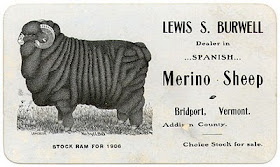When I was a child, every summer my family would visit Northfield Falls, Vermont, site of the home which had been in my father’s family since 1898. As an adult, on the way to visit my paternal Grandma Helen (my original knitting mentor), I would stop at Green Mountain Spinnery in Putney VT on my drive up I-89, from Riverdale-On-Hudson, (a fancy way to say the north Bronx) New York, and later Andover, Massachusetts... stopping at the Spinnery was a way to get in to the fiber mind frame for the weekend, which always involved lots of knitting. In autumn, another fun stop during a visit to Vermont was a trip to the Vermont Sheep and Wool Festival.
Another fibery connection to Vermont came up last month when I showed my Dad my post on Eliza Lucas Pinckney. He reminded me that a distant ancestor who lived on a merino sheep farm in Ferrisburgh, Vermont, called Rokeby. I visited Rokeby Museum on one of those visits to Vermont. Here's a photo of the main house at Rokeby Museum:
Rokeby Museum, used with permission.
View Larger Map
Stevens is a family name, middle name of both my father and brother. My four great grandfather’s brother was grandfather to Anne King Stevens (1841-1920):
Rokeby Museum, used with permission.
Anne was married to Rowland Evans Robinson (1833 – 1900):
Rokeby Museum, used with permission.
Rowland was an artist and writer. Four generations lived at Rokeby. Anne and Rowland were of the third generation. The Robinsons were “Quaker millers, farmers, abolitionists, authors, naturalists, and artists” according the Rokeby website. The farm was a site of an Underground Railroad stop one generation prior to Anne and Rowland.
Merinos are a very old sheep breed. Merinos are suspected to have originated in North Africa, but were established and named after importation to Spain. They tolerate the heat of a warmer climate, but tolerate cold weather, and have heavy folds of skin which help to produce a large weight of fleece per animal. They eat grass and low lying shrubs, and have a relatively low need for water. During the Spanish Empire, they could not be exported from Spain, on the pain of death.
Merino fleece is very soft and fine, and merino garments are soft and easily worn next to the skin. The wool is lofty because of the fine crimp in it; it makes a warm lightweight garment. These qualities made and continue to make it highly desirable as a wool produce.
In 1810, Rowland’s grandfather Thomas imported some of the first merinos to be imported in to the United States. Merino farming was very lucrative in the early 1800’s, sheep being low maintenance and tolerant of Vermont’s cold weather. About the same time, William Jarvis, a Vermonter who was US Consul to Portugal, facilitated importation of merinos to the US. Jarvis took advantage of Napoleon’s takeover of Spain in 1808 during the Peninsular War, allowing for export of merinos from Spain, following this defeat of the Spanish Empire. Here is a drawing by Rowland of a merino:
Rokeby Museum, used with permission.
By 1837 there were over a million sheep in Vermont. By 1840, Vermont had the highest number of sheep per capita in the country. Drovers would lead the sheep from the Vermont countryside to Boston.
In Vermont, the success of the merino industry did not last more than several decades. The Midwest was settled, where sheep could be raised more inexpensively. The Vermont sheep industry did not continue to any great extent after that time. Sheep farming was replaced by dairy farming in Vermont, which is exactly what occurred at Rokeby, as the family's farm business changed with the times.
Rokeby became a museum in 1961 upon the death of Elizabeth Robinson, the last family member to live on the site. According to the website, it is one of the better documented stops on the Underground Railroad. Rokeby was designated a National Historic Landmark by the National Park Service in 1997. The museum is open from mid-May to mid-October.
We missed both: Vermont Sheep and Wool was last weekend, and Rokeby is closed likely this week. Have a visit to Rokeby next spring, and Vermont Sheep and Wool Fest in October 2011.
We missed both: Vermont Sheep and Wool was last weekend, and Rokeby is closed likely this week. Have a visit to Rokeby next spring, and Vermont Sheep and Wool Fest in October 2011.
Sources for this post include:
http://vermonthistory.org/index.php
option=com_content&task=view&id=298&Itemid=176
and
http://Rokeby.org
Many thanks go to Jane Williamson at Rokeby Museum, and to my Dad, whose middle name is Stevens and who goes by "Steve," for the inspiration.
There are at least several farms in Vermont that currently raise merinos, including
this one I visited here years ago and during our visit Margaret served us EXCELLENT colcannon
and
this one which interestingly is located in Ferrisburgh
option=com_content&task=view&id=298&Itemid=176
and
http://Rokeby.org
Many thanks go to Jane Williamson at Rokeby Museum, and to my Dad, whose middle name is Stevens and who goes by "Steve," for the inspiration.
There are at least several farms in Vermont that currently raise merinos, including
this one I visited here years ago and during our visit Margaret served us EXCELLENT colcannon
and
this one which interestingly is located in Ferrisburgh





Very interesting reading. I had a pm from a German knitter who told me that most German yarn is merino wool.
ReplyDeleteThis website is remarkable information and facts it's really excellent. Please visit instagram viewer
ReplyDelete